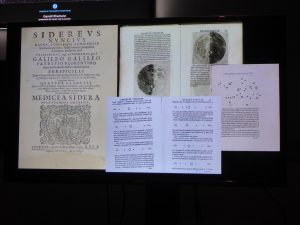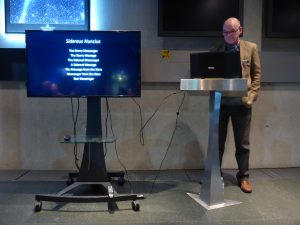November 14, 2017
“Sidereus Nuncius, The Starry Messenger” – History of Astronomy Group Meeting – 14th November 2017
Andy Sawers
Report by: Bobby Manoo
 It was a late Friday night many years ago that Andy Sawers stood in front of the National Portrait Gallery in London, awaiting the night bus to get home. He glanced around and saw a man standing in front of a telescope offering passers-by a view of the Galilean Moons for 50p. Andy took him up on that offer and it turned out to be the best thing he ever did as it triggered Andy’s interest to find out more about the discovery of those Moons.
It was a late Friday night many years ago that Andy Sawers stood in front of the National Portrait Gallery in London, awaiting the night bus to get home. He glanced around and saw a man standing in front of a telescope offering passers-by a view of the Galilean Moons for 50p. Andy took him up on that offer and it turned out to be the best thing he ever did as it triggered Andy’s interest to find out more about the discovery of those Moons.
This was the opening storyline to the season’s first meeting of the History of Astronomy Group in a fantastic talk by Andy Sawers. Andy is the current Chair of the Flamsteed Astronomy Society and has a keen interest in the history of astronomy, especially the Copernicus-Tycho Brahe-Galileo period. As a result of Andy’s research into this period, we were all able to delve into the mind and thoughts of Galileo as Andy took us through the pages of Sidereus Nuncius, The Starry Messenger, which was Galileo’s first publication in 1610.
After agreeing on the pronunciation of the title, we were given a synopsis of what is included in this publication and what is not. Andy explained that this work was focused on several discoveries including the postulation that the Moon’s surface is rough with mountains and valleys, that the Milky Way is composed of stars, and the discovery of four moons around Jupiter. It did not include discoveries of the phases of Venus, Saturn’s rings, sunspots or any other items which got Galileo into trouble with the inquisition – these were the subjects of later publications. We also got an insight into the life of Galileo in the year 1609 as Professor of Mathematics at Padua University, near Venice.
Andy turned on his deep, husky medieval voice to read the cover of Sidereus Nuncius where Galileo proudly proclaimed the intended audience of his paper and the discoveries based on his observations. We were then shown some of Galileo’s drawings of the Moon which captured the significant features we know today. Galileo was able to prove the existence of mountains and valleys and commented that there was a large cavity “like Bohemia” on the Moon and the surface was not smooth and perfect as previously thought. He even attempted to calculate the height of a mountain peak using trigonometry.
 Attention then turned to some of Galileo’s other drawings of Orion and the Pleiades. In each of these examples, Andy showed side by side images of the drawings and actual photographs taken by members of the Flamsteed Society. It was remarkable how accurate the drawings were given the tools which Galileo had to work with.
Attention then turned to some of Galileo’s other drawings of Orion and the Pleiades. In each of these examples, Andy showed side by side images of the drawings and actual photographs taken by members of the Flamsteed Society. It was remarkable how accurate the drawings were given the tools which Galileo had to work with.
Much of the remaining time was spent in reviewing the drawings and commentaries which Galileo made based on his observations on the planet Jupiter and the ‘stars’ which he saw around it. There were a total of 65 observations made between January 7th and March 2nd 1610. His paper was published on 13th March and had a print run of around 550.
In many of the slides, Andy presented the drawings of Galileo together with screenshots from the application Stellarium, which was configured to show the night sky at the time of Galileo’s viewings. This allowed the audience to understand Galileo’s observations and at the same time reflect on his commentary to see how his interpretations and understanding evolved night after night. Andy demonstrated how Galileo used the position of a fixed star to prove that four ‘stars’ close to Jupiter actually orbited the planet and moved with it along its own orbit around the Sun. In instances where only two or three stars were visible to Galileo, the Stellarium screenshots showed us why this was so, in that either the objects were very close together or hidden behind Jupiter.
Years after the publication, Simon Marius was one who attempted to plagiarise Galileo’s work but he was eventually busted. The Starry Messenger proved to be a remarkable achievement despite the early evolution of optics and the challenges of understanding these observations.
Thanks to Andy for a wonderful talk and informative insight into the Sidereus Nuncius.
Pictures from the evening (by Bobby Manoo):
Posted under: Flamsteed, History of Astronomy, Meeting Report




You must be logged in to post a comment.